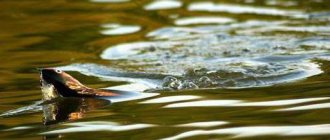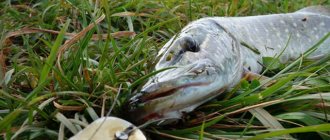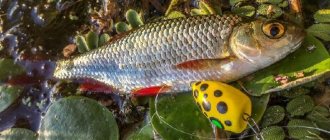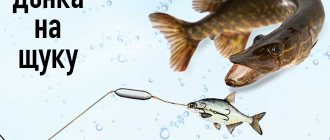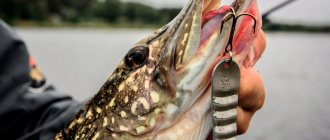The right pike popper is not just another bait that is useful to check when looking for workable options. In shallow waters or at their border with depth, especially in summer, it is these surface topwaters that can make fishing, since they don’t take any other baits at all. Naturally, there are features and nuances in using such bladeless wobblers. Let's take a closer look at how to catch pike with a popper, and which lures on the market really work and are catchy.
What is a popper
The front of the popper has a beveled plane with a notch in the middle. With a sharp jerk with the tip of the spinning rod, the recess of the popper captures an air bubble and, as it moves, spits it out, creating a special sound reminiscent of squelching or gurgling, and also scatters splashes of water in all directions. The size and shape of the notch affects the volume and pitch of the sound produced by the popper.
The gurgling sounds, floundering, splashes and splashes made by the popper attract the attention of predatory fish, which approach the bait and attack it.
With its appearance and behavior, a popper can remind a predator of either a small fish feeding on the surface of a reservoir, or a small frog, a mouse swimming in the water, or even a large beetle that has fallen into the water and is floundering on the surface.
The first poppers appeared in the USA in the 1930s and were used primarily for bass fishing. In Russia and the territory of the countries of the former Soviet Union, the first poppers appeared in the 90s of the 20th century and began to be used for catching pike and perch. Currently, poppers are the most popular surface bait.
Poppers get their name from the English word “pop”, which translates as “gurgling”. Literally, the word popper can be translated as gurgling.
Most poppers are equipped with two tees. One tee is located on the belly of the bait, the second in its tail. The tail tee of many poppers has a tail fin in the form of an edge, which serves to attract additional attention from the predator.
Some poppers are equipped with internal chambers with balls, which, when inserted, create strong acoustic vibrations, which additionally attract the predator.
Poppers are surface baits; the angler has the opportunity to both visually monitor the bait’s movement and, in most cases, see the very moment the predator attacks the popper.
Poppers provide an excellent casting range, allow you to fish snags and areas of water bodies overgrown with aquatic vegetation, and are simply very catchy.
How to choose a popper

I recommend that you be very responsible when choosing your first popper. Since we are talking about the first such bait in your practice. After all, a negative fishing experience can negatively affect future attitudes towards the class of baits as a whole.
Poppers are made from balsa, plastic and even silicone. For example, there is a silicone popper called Garry Angler. It perfectly copies natural fish and bites on it happen very often. However, silicone has one big disadvantage: it deteriorates very quickly. Pike easily tears this bait with its sharp teeth.
If you wish, you can make this miracle yourself. On the one hand, there is nothing complicated about it and it will certainly attract fish. On the other hand, you can simply buy ready-made bait. Here, each angler must make his own choice.
When choosing a popper, pay attention to how well the body is made, whether there are imitation eyes and gill covers, whether it is equipped with a noise capsule, and how high-quality the hooks are on the bait. Size also plays a huge role. In the case of pike, you should choose a popper with a length of 50 to 100 mm. If we are talking about catching perch or asp, then you should choose smaller baits. For perch this value ranges from 30 to 50 mm, and for asp - from 40 to 60 mm.
In general, it is better not to waste money and buy a popper from a reputable manufacturer. One that has a good reputation and is time-tested. Before purchasing, it is best to watch video reviews and read reviews from real users. Fortunately, there are a huge number of them on the Internet.
Poppers such as Yo-Zuri 3D Popper and Rapala Skitter Pop are generally recognized flagships. Surely a beginner will not be disappointed if he purchases them.
Recommended reading: Tackle for carp with makukha
What is the best time to fish?
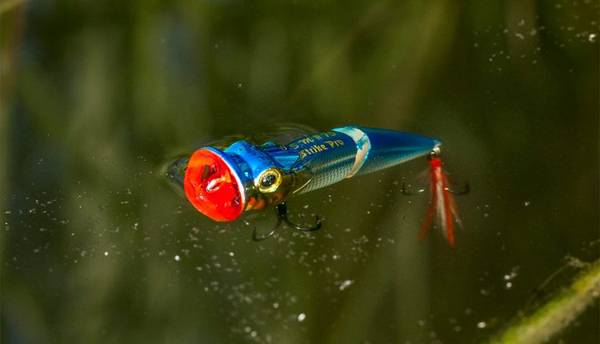
Popper fishing can be done throughout the open water season, but the best time to fish for popper is from late May to mid-August. The popper shows its greatest effectiveness in the hottest time of the year, when the predator, due to the low oxygen content in the water, prefers to stay closer to the surface, in the upper layers of the reservoir, notices a moving bait and instantly rushes at it.
Popper fishing is best during the early morning hours and before sunset. At this time, predators are at their maximum level of activity.
For popper fishing, you should choose calm, windless weather. Rain, wind and waves on the surface prevent the popper from making characteristic squelching sounds, which deprives it of a significant share of its attractiveness in the eyes of a predator.
What types are there
At the moment there are a huge number of poppers. The color is very diverse, but in the lower part of the product and at the cut site it is always bright. The upper part is lighter - bluish tints.
Predators are mainly interested in the lower part, since that is what they see.

The product has 2 tees. One is from below, the other is in the tail. The tail part is often decorated with feathers. It is believed that this attracts predators.
We also recommend reading:
Model range of Salmo wobblers and Salmo Hornet catalog Bait for crucian carp - recipes for super bait with your own hands Spinner for pike - 10 best and how to make it yourself? Tackle and bait for fishing for carp - selection and production
The size is chosen based on what you are going to hunt. So, for pike, an 8-centimeter bait would be ideal, and for perch, a 6-centimeter bait. There are products reaching 13 cm. They are used for the largest fish.
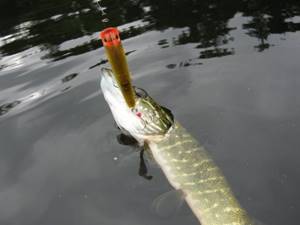
Where do they fish with poppers?
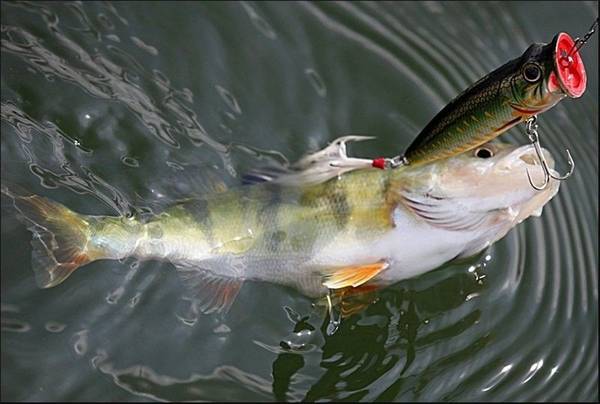
For popper fishing, shallow areas of reservoirs with standing water, overgrown with duckweed and other aquatic vegetation, are best suited. These can be shallow bays of larger reservoirs, floodplain lakes, overgrown river oxbows, ponds overgrown with duckweed and grass, and toad grasses. In such places there are a lot of small fish, which are prey for the predator lying in wait for it. During the hottest time of the year, when the predator is at the peak of its activity, you can also effectively fish with a popper at depth in a large body of water.
When and where to use
It is used in areas of the reservoir with shallow depth. Quite often, these areas are distinguished by the presence of a lot of algae, as well as other natural shelters. Here the predator prefers to hide from the sun and hunt.
The first peak of effectiveness of surface baits occurs in late spring. At this time, the predatory fish, having spawned, begins to actively feed. At the same time, they often hunt in the same areas where spawning took place. And such places are usually characterized by shallow depth. The popper in this case imitates small spawning fish. Of course, the predator does not miss the opportunity to feast on such easy prey.
The second peak occurs during the period when it is hot outside. During the summer heat, it is often impossible to attract a predator with any bait. And only a popper at minimal fishing speeds can interest an asp or pike. So if you have tried the usual baits, but there is no result, you should use a popper.
In the first half of autumn, the predator begins to actively feed, preparing for winter. At this time, predatory fish still respond well to surface baits. Again, you need to choose relatively shallow water areas for fishing. But in the second half of autumn it is better not to take this bait out of the box. As the weather gets colder, predatory fish move to deeper areas and become uninteresting.
We recommend reading: How to tie a jig to a winter fishing rod
Popper fishing reel
Popper fishing places increased demands on the reel. The reel should provide good laying of the line, with uneven wiring with large jerks and sudden stops. When fishing with a popper, while reeling in the line, the tension of the line is constantly changing. When winding, the line is placed on the spool both with and without load. A reel that does not provide ideal line laying will create “beards” when casting. Many anglers prefer reels with an endless screw.
The optimal reel size for popper fishing is from 2000 to 3000, the gear ratio of the reel is at least 1:5. The reel must have an instant reverse stop.
When fishing with poppers, braided fishing line is used. The braid, due to its low elongation, provides the necessary sharpness of the wiring. When fishing for pike with a popper, be sure to use a leash. It is better to use a leash made of steel wire, since braided leashes are often twisted into rings.
How to assemble a balanced tackle
The rating of poppers for pike is, of course, a useful thing, but this is not enough for successful fishing. At a minimum, you need a good spinning rod, and not only the rod itself, but also the entire set - reel, fishing line, various accessories.
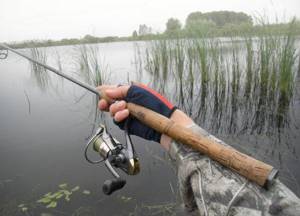
Rod parameters
Considering the small weight of poppers, appropriate spinning rods should be used. First of all, this concerns such requirements as action, test load, lightness and length of the rod.
Recommended reading: Diversion leash
According to the test, poles with a load of up to 25 grams are better suited. They will allow you to safely use most common popper models. The best action is fast; this allows you to make sharp short jerks, during which the bait moves as realistically as possible. For fishing in snags or among thickets of vegetation, a long rod is not needed; a stick 2.1 - 2.4 m long is sufficient.
The weight of the rod also matters, because you have to hold it in one hand for a long time, and at the same time play with the bait. For such conditions, it is better to use a lightweight carbon fiber spinning rod.
Coil
A regular inertia-free reel will do just fine. The main thing is that it lays the line evenly, and is correctly adjusted and does not form humps and depressions. If this requirement is not met, then “beards” are possible.
fishing line
It is best to use thin, but very tear-resistant braid. The cord, of course, also has stretchability, but to a much lesser extent than regular nylon fishing line. The braid is able to withstand numerous jerks of the caught fish and allows you to quickly unhook the bait from the vegetation.
Leashes
This element of gear is indispensable when fishing for pike. An attempt to tie a popper directly to the line often results in the predator cutting the line with its teeth while fishing. You can use steel string, fluorocarbon or tungsten as a leash. It's a matter of taste.
Popper characteristics
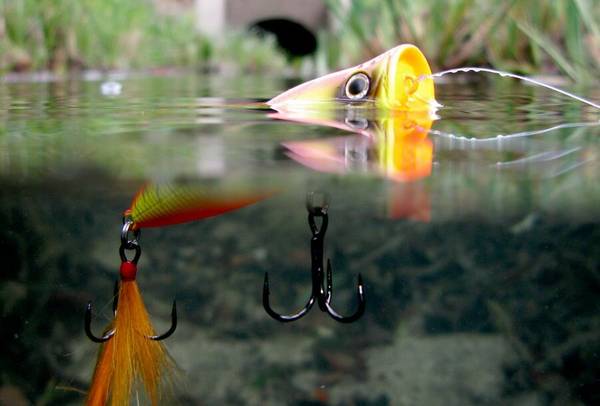
Fishing stores offer a wide range of different poppers, differing in their characteristics.
Degree of buoyancy
According to the degree of buoyancy, poppers are divided into two large groups:
- Floating poppers
- the vast majority of poppers presented in fishing stores are of the floating type. Since, first of all, the popper is a surface bait. Floating poppers are effective when fishing in shallow, vegetated waters. - Sinking poppers
are a much rarer type of popper. During a pause, they plunge into the water, and when jerking, they rise to the surface, emitting a characteristic gurgling sound. When fishing with sinking poppers, a more aggressive retrieve is required at a fast pace with minimal pauses. Provides greater casting distance.
You may be interested in: Spoons for pike
Size
Properly selected popper size plays an important role in fishing efficiency.
- To catch pike, you should use poppers 8-9 cm long. In autumn, the size of the bait can be increased to 12 cm.
- Poppers with a length of 4-5 cm are best suited for catching perch. Closer to autumn and in those places where there is a possibility of catching a large perch, the size of the bait can be increased to 7 cm.
- To catch asp, you should use poppers 7-8 cm long.
- Poppers 4-5 cm long are best suited for catching chub and ide.
Weight

Most poppers weigh between 4 and 16 grams. The weight and size of the popper are selected depending on the type of predator you are catching. The greater the weight of the popper, the greater the casting distance.
Form
Poppers can have different body shapes. There are poppers with a thicker body and thinner ones. Thicker poppers produce a louder gurgling sound and a stronger spray while traveling in a straighter path. Thicker poppers should be used when there are ripples or waves in the water. Thinner poppers produce a quieter gurgle and a smaller fountain of splashes, but when moving in the water they yaw more strongly from side to side. They are best used when the predator is in a more passive state.
Color
The color of the popper does not play a big role. With different light levels, degrees of water transparency, time of year and day, a certain color may be more catchy than others. The fish sees the popper only from below, against the sky. The lower part of the popper can have either a natural color, matching the color of the fry, or a bright, contrasting color, clearly visible against the sky. The top of the popper should be brightly colored so that the angler can distinguish it in the water and have visual control over the movement of the bait.
Poppers for pike
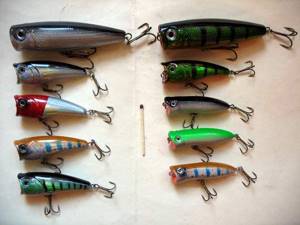
Bright colors are especially important in sunny weather, and the water in the reservoir should be clear. Models with natural colors work well.
Due to a special dimple located in the central part of the nose, the bait emits a sound impulse when reeling sharply.
Poppers are distinguished:
- Sinking , when cast, they sink to the bottom of the reservoir, and with sudden movements they instantly rise to the surface.
- Floating , designed for fishing hard-to-reach places.
It is important to know that a sinking popper only works with active and sharp retrieving; it is recommended to use it as a search engine for predatory fish, and it is advisable to hunt a floating product.
To choose a catchy popper, you need to pay attention to the following nuances:
- Lure size. To catch a clever pike you will need a large product; the larger the popper, the better the catch. Lures with a length of 10–25 cm are especially popular, but you should know that the largest popper in size does not always catch a large predator.
- Product form. The design of the bait is made in a cone-shaped design, where the wide head smoothly transitions into a narrowed tail. An additional element are large tees.
- Model color. The color of the surface product is not of fundamental importance, the main thing is that attractive sounds are produced. Many anglers argue that the color of the popper should be selected in accordance with the fishing conditions and time of day. Thus, for hunting in the morning and evening hours, it is recommended to use black, orange and red baits.
The color of the front of the popper plays a significant role in controlling the bait; it should be brightly colored. If the original color does not suit the fisherman, you can update it yourself.
Rating of the best models
Megabass Pop Max
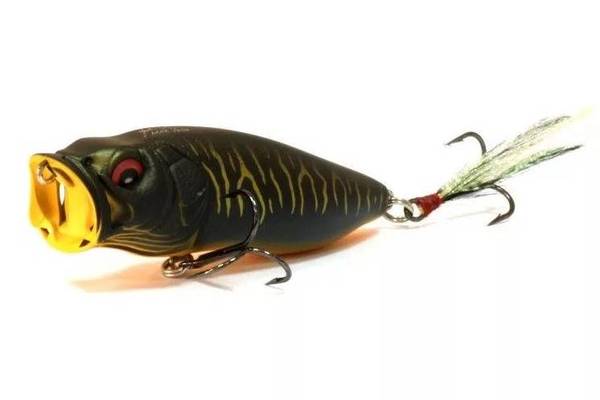
The Megabass Pop Max popper is deservedly considered one of the best poppers for pike fishing. Company founder Yuki Ito took an active part in the development of the Megabass Pop Max popper. The bait has a length of 78 mm and a weight of 14 g. The popper has a system of hydraulic channels, holes and chambers that create acoustic effects when retrieving. The Pop Max Weight Setting system makes the bait actively wobble when retrieving. The bait works both on standard popper wiring and on walker wiring. The Megabass Pop Max popper produces the crispest wolf pattern of any popper.
Jackall SK-Pop
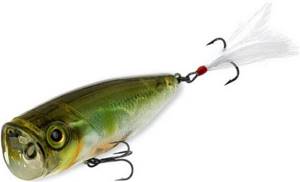
The Jackall SK-Pop popper is perfect for catching pike, perch and asp. The popper is available in two models, 53 and 65 mm long, weighing 6.5 and 9 grams. There is a plexiglass weight in the front part of the popper, and a metal ball in the back part of the popper. The rear hook of the popper has a lurex edge. The popper has excellent flight qualities and makes a short and loud gurgling sound in the water. The Jackall SK-Pop popper can be used to quickly fish a large area of water; if there is a pike in the reservoir, the popper will quickly find it. When fishing with this popper, you should use a slow retrieve, with short and sharp jerks. After several jerks, you should pause, during which the predator’s attack most often occurs.
Yo-Zuri 3DS Popper
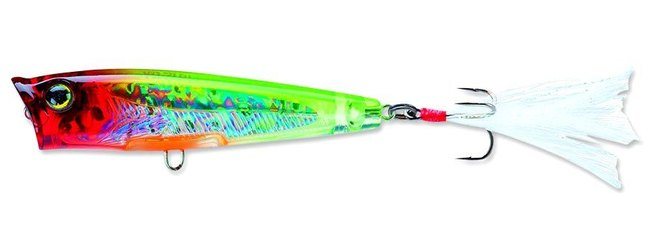
The Yo-Zuri 3DS Popper is considered by many anglers to be the best popper of all. The popper is 65 mm long and weighs 7 grams. The popper is made of high-quality plastic; inside the body there is a holographic layer, which ensures light refraction and creates the effect of a three-dimensional image. The popper has excellent flight qualities. Inside the popper body there are two metal balls that ensure proper balancing of the bait, provide a high casting distance and create a special acoustic effect. The Yo-Zuri 3DS Popper is used for catching pike and perch. When fishing with this popper, you should use a retrieve at a slow pace, alternating sharp jerks with long pauses.
OSP Louder
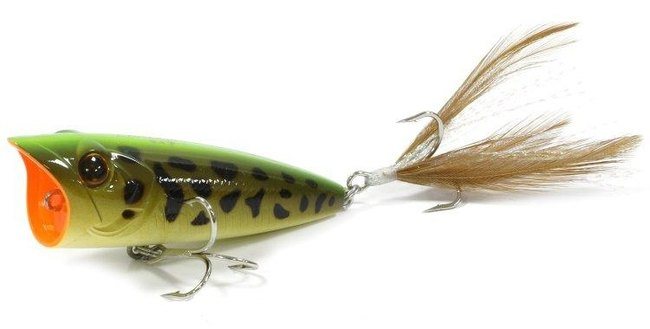
The OSP Louder popper is the first popper presented in the assortment of the OSP company, which is well known to anglers. The popper is presented by the manufacturer in two sizes, 60 mm long, weighing 8.4 grams, and 70 mm long, weighing 12 grams. The popper has a large metal ball placed at the bottom of the bait to ensure casting distance and accuracy. There are also metal balls located in the abdominal part, which create a loud knocking noise that attracts predators from a great distance. In the water, the popper is located almost vertically. Thanks to the unusual shape of the muzzle, with a long nose, the popper gurgles loudly and splashes heavily with water when jerking.
Lucky Craft Sum Malas
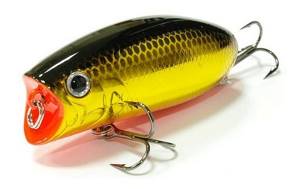
The Lucky Craft Sum Malas popper combines the properties of three classes of bait. On a uniform retrieve, it sinks down to a maximum of 20 cm and, like a wobbler, plays, swaying from side to side. At a low line reeling speed, the popper will go almost along the surface, leaving characteristic whiskers on it. When using jerk wiring, the Lucky Craft Sum Malas, like a regular popper, makes a gurgling sound and creates splashes of water. With a walking-the-dog wolf retrieve, the bait behaves like a wolf moving along the surface of the water. The popper is 57 mm long and weighs 9 grams. Thanks to its compact size and significant weight, it has excellent flight range and accuracy. The main targets for fishing with it are pike and perch.
Strike Pro Pike Pop

The Strike Pro Pike Pop popper is presented by the manufacturer in two sizes, having a length of 60 and 70 mm and a weight of 6.5 and 10.5 grams. The rear tee of the popper is equipped with a fly, which stabilizes the action of the bait and additionally attracts the predator with its vibrations. The popper is well suited for catching pike, perch, and can also be used for catching asp. Thanks to its good flight characteristics, the popper allows you to fish large areas of water with its help. The popper can be specifically used for catching perch and asp in pots. When fishing with this popper, you can use both a classic popper with sharp jerks, and a walker, in which the popper moves like a snake along the surface of the water.
You may be interested in: Minnow: characteristics, size, color, wiring, tips, photos, videos
Daiwa TD Popper Zero
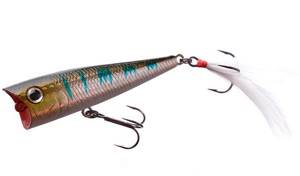
The Daiwa TD Popper Zero is an excellent Japanese popper for catching pike and perch. The popper is 65 mm long and weighs 7 grams. The popper is distinguished by high quality workmanship, good casting range and realistic play. The popper shows maximum efficiency when fishing over thickets of aquatic vegetation in reservoirs with standing water or weak currents. With its loud splashes, the popper is able to attract a predator from a long distance. When dropped onto the water after casting, the popper creates a noisy splash that attracts pike and perch with its loudness. The body of the bait is made of high-quality plastic and has a coating that is resistant to pike teeth.
DUO Realis Popper
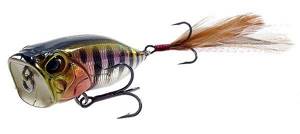
The DUO Realis Popper has a distinctive, original appearance, for which it was nicknamed “the little Japanese miracle.” The popper is 64 mm long and weighs 9 grams. Thanks to the good aerodynamic characteristics of the popper, we have a high casting range. The main targets for fishing with this popper are pike and perch. The popper body is made of plastic and has a high-quality coating. When jerking, the popper actively gurgles and creates strong splashes on the water. The manufacturer offers poppers in various colors to suit a variety of fishing conditions.
Rapala Skitter Pop

The Rapala Skitter Pop is well suited for anglers new to popper fishing. The popper is made of balsa and is therefore not particularly resistant to pike teeth. The popper is produced in three sizes 50, 70 and 90 mm, the 50 and 70 mm long models weigh 7 grams, the 90 mm long model weighs 14 grams. A 50 mm long popper is well suited for catching chub, ide and asp during periods when they feed from the surface of the reservoir. Popper lengths of 70 and 90 mm are suitable for catching pike and large perch. The popper is presented by the manufacturer in more than a dozen colors. The popper allows you to catch fish using a retrieve consisting of jerks of different strengths and pauses of different durations, as well as pulling and even moving the popper in place.
Yo-Zuri EBA Popper
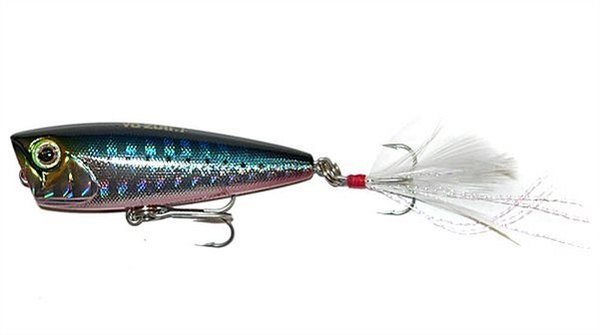
The Yo-Zuri Eba Popper is very suitable for catching perch, it is 5 cm long and weighs 4 grams. The popper's body has detailed scales, clearly defined gills, and large voluminous eyes. A thin layer of holographic coating located inside the body of the wobbler reflects light and provides a realistic appearance. Despite its light weight, the popper has a good casting range. It is best to move the popper at a not very fast pace, without strong splashes. The popper provides the best results when fishing in toad grasses and water lily thickets.
Owner Gobo Popper

The Owner Gobo Popper is an excellent bait for catching perch and small pike. The popper is 60 mm long and weighs 6.3 grams. The popper has an excellent casting range and allows you to fish with it even in side or head winds. The popper is equipped with a system of movable, noisy balance balls. The rear hook of the bait has a tail. When retrieved, the popper maintains a horizontal position and moves along the surface of the reservoir with slurping sounds and yaw movements.
Megabass Pop-X
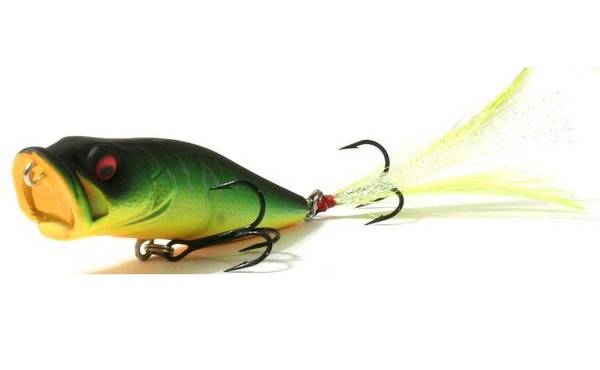
The Megabass Pop-X popper is one of the best poppers for catching perch and pike weighing up to 1.5 kilograms. The popper can be 64 or 65.5 mm long and weighs 7 grams. Holes in the popper body allow water to pass through, providing an additional acoustic effect. A heavy ball rolls in the transverse channel in the body of the popper; another ball located in the tail of the bait provides a good casting range. The popper is highly effective when catching passive fish.
Tsuribito Jerk Pop
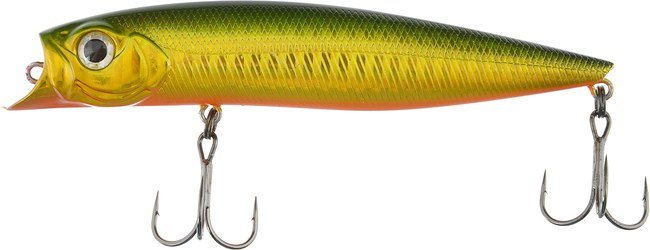
The Tsuribito Jerk Pop is an excellent lure for catching pike in weedy shallows. The body of the bait is made of high quality plastic. The popper is presented by the manufacturer in two sizes: 90 and 110 mm long and weighing 11 and 14.4 grams. When jerking, the popper is buried to a depth of up to 50 cm, and then quickly floats to the surface, which allows it to be effectively used for catching pike over thickets of grass. With short jerks it creates noise, gurgling and splashing, which provokes the predator to attack the bait. This popper can also be fished using a uniform retrieve and a step pull.
Strike Pro Giant Pop
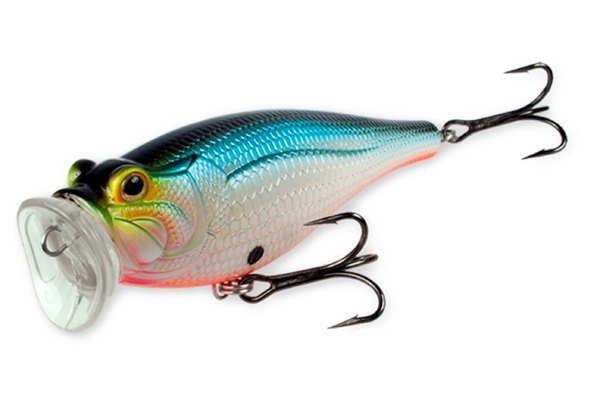
The Strike Pro Giant Pop 160 is 160mm long and weighs 85.5g. The popper is designed for catching large trophy pike. The heavy weight and high tenacity of the popper in water place increased demands on the spinning rod and reel. To fish with this popper, you should use a powerful jerk rod and an appropriately powerful baitcasting reel. The popper is made of high-quality impact-resistant plastic and is equipped with a noise chamber that creates low-frequency noise that attracts pike. Thanks to its long casting range, the popper allows you to quickly fish a large area of water.
Kosadaka Killer Pop

The Kosadaka Killer Pop is a budget-friendly bait that is well suited for anglers new to popper fishing. The popper can be used for catching pike, perch and asp. The manufacturer offers bait in two sizes: 80 and 100 mm, weighing 14 and 26 grams. The popper has a good casting range. The Kosadaka Killer Pop popper does not have noise chambers; after casting, it takes a semi-vertical position in the water and, when jerked, creates a large amount of splashes. The popper is presented by the manufacturer in fifteen different colors.
You may be interested in: Fishing in Karelia: 30 best places
River2Sea Bubble Pop
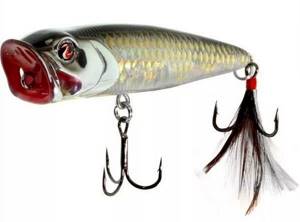
The River2Sea Bubble Pop popper is produced by the Australian company River2Sea, well known to anglers. The popper is produced in the following sizes: 35, 45 and 65 mm. The popper is designed for catching perch, chub, and small pike. The bait has a high-quality body coating that reliably protects it from the teeth of predators and a special system of weights that increases the casting distance and accuracy. There are special slots on the sides of the bait's head, thanks to which the popper not only gurgles, but also releases air bubbles that attract the attention of the predator. When fishing with this popper, you should use twitching and stop-and-go fishing.
Pontoon 21 BeatBull

The Pontoon 21 BeatBull popper is well suited for perch fishing for beginner spinning anglers. The popper is 55 mm long and weighs 4.1 grams. The popper can be animated with a variety of different movements, which is especially important for beginners in mastering this type of fishing. When the line is reeled evenly, the popper scours from side to side, and when pulled jerkily, as befits a popper, it gurgles, slurps, and creates splashes of water. The popper is presented by the manufacturer in a large number of different colors designed for different fishing conditions.
Lucky Craft Bevy Popper

The Lucky Craft Bevy Popper is an excellent bait for catching perch and small pike. A high-quality coating reliably protects the popper from sharp pike teeth. The popper is 48.5 mm long and weighs 4.2 grams. Produces good sound and vibration on the surface of the water, thanks to the feathering on the tail tee. According to many experienced spinning anglers, this is the best popper for catching perch.
Rapala X-Rap Pop

The Rapala X-Rap Pop has been produced by Rapala since 2012. The popper body is made of plastic. Popper length 70 mm, weight 11 grams. The popper is equipped with a long-distance casting system, so it has excellent range. Using different types of wiring, an angler can make the popper make gurgling, slurping, squelching sounds, create splashes, and spray water. The popper is well suited for catching pike in shallow waters and in thickets of vegetation.
Berkley Frenzy Popper
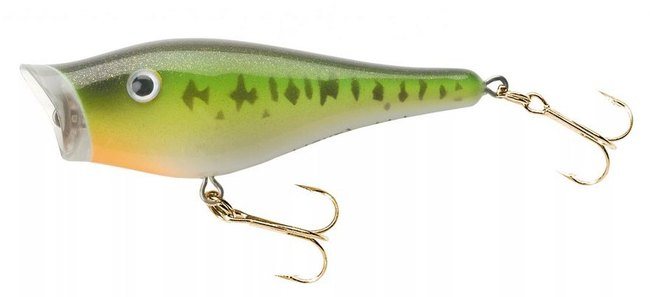
The Berkley Frenzy Popper belongs to the budget category of baits. The popper is 70 mm long and weighs 9 grams. Thanks to its compact size and significant weight, it has quite good flight qualities. The popper works great for perch and pike. When fishing with it, you can use a variety of animation methods. With a uniform drive, the popper yaws from side to side, and with a jerky drive, it gurgles, slurps, and creates splashes of water.
Popular Popper Models
In order to choose the right bait for a predator, you should pay attention to products from well-known manufacturers. Such products are especially popular among professional fishermen.
Among the popular models:
poppers are also widely used to catch predators . The peculiarity of such baits is that they can have different sizes and weights. This means that you can select bait directly to the size of the predator. The largest popper has a length of 6.4 cm and a weight of 14 g. Depending on the size, the cost of such baits can range from 250 to 460 rubles.

Daiwa TD Popper Zero is a surface bait. Its weight is only 6 g and its length is 6.5 cm. The bait is equipped with two hooks with three points. These poppers are mainly used for catching small predators. The cost of the bait is 440 rubles.

ECOGEAR TP 88F is equipped with two treble hooks, which are placed in the rear and middle part of the bait. The length of the popper is 8.8 cm, and the weight is 17 g. This bait costs about 500 rubles.
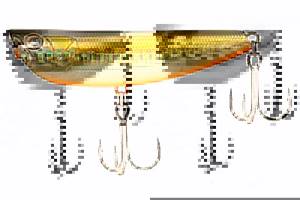
A good option for catching small and medium-sized predators is the Rapala Skitter Pop. This bait is especially suitable for novice fishermen. Unfortunately, it is not resistant to the teeth of predators. This bait costs a little more than 500 rubles.

JACKALL BROS SK-Pop Grande. This popper is 7.5 cm long and weighs 9 g. Thanks to its special shape and placement of hooks, the popper is very easy to use. It makes a pleasant sound while playing. The cost of such bait reaches more than 800 rubles.
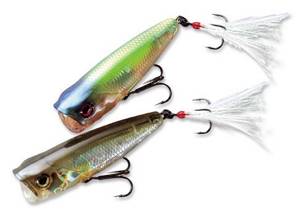
When choosing a bait, you should take into account not only its color, size or cost, but also your casting skills. Heavy weight poppers can present some challenges when casting.
Popper fishing

When fishing with a popper, the spinning rod is held at an angle of 45 degrees relative to the surface of the water. The closer the popper is to the angler, the lower the tip of the spinning rod should be lowered relative to the surface of the water. Depending on the specific fishing conditions, the angler selects the speed of the retrieve, the position of the rod and the force of the jerk.
When fishing with a popper, you should use the following fishing technique:
- After casting the bait, you should pause for 2 seconds so that the popper takes the correct position in the water.
- Close the reel bail and take up the slack in the line.
- Make a small jerk with an amplitude of 20 cm with the tip of the rod.
- The popper will dash forward with a corresponding sound.
- Pause for 2 seconds, take up the slack in the line and repeat the jerk.
When fishing with a popper, it is important to choose the right jerk strength. When fishing in deep water, in windy weather and in slight waves, you should perform stronger jerks; when fishing in shallow water, in calm weather, you should make jerks of moderate force.
In order to determine the correct jerk force for a particular popper model, you should pay attention to the sound produced by the popper; it should be quite loud and gurgling, with small fountains of splashes coming from the popper.
When fishing with a popper, you should definitely take pauses; it is during pauses that a predator attacks the bait most often. If the predator often misses the popper, the duration of the pause is not enough; the duration of the pause between jerks should be increased to 4-5 seconds.

When fishing with a popper, you should not rush to hook; it should be done not when the predator is about to attack, but after a tangible blow to the bait.
A predator can attack a popper from a variety of angles, so when fishing with a popper you should use leashes at least 15 cm long.
When fishing with a popper, you can use several types of wiring:
- Classic retrieving
consists of jerks, alternating with pauses, during which the angler picks up the slack in the line by rotating the reel handle. The jerks can be alternated, first long, then shorter. - Monotonous retrieving
is carried out by constant rotation of the reel handle, which is accompanied by short jerks with the tip of the spinning rod. - Aggressive fishing
is used when catching an active predator and consists of sharp, frequent jerks with the tip of the spinning rod, with virtually no pauses. With aggressive fishing, the popper moves along the surface of the water, constantly jumping out of it, imitating a fry running away from a predator. - Slow retrieval with frequent long pauses
is used to catch a passive predator, simulating a wounded and exhausted fish. Consists of short, sharp jerks, alternating with pauses of 3-4 seconds. - Pulsating wiring
imitates the movement of a frog on the surface of the water. By twitching the tip of the spinning rod, a slight acceleration is given to the popper, then the reel is evenly reeled in, causing the popper to slide along the surface, then the movement of the popper is again accelerated by twitching the tip of the spinning rod. - Wiring consisting of a series of jerks and pauses
is successfully used in the middle zone at the end of autumn; wiring consists of a series of 3-4 strong and frequent jerks, followed by a pause of 4-5 seconds. - Chaotic wiring
consists of jerks of varying strengths, which alternate with pauses of varying durations.

